The Tunable Electronic and Optical Properties of Two-Dimensional Bismuth Oxyhalides
Abstract
:1. Introduction
2. Calculation Methods
3. Results and Discussions
3.1. Crystal Structure and Stability
3.2. Thickness-Dependent Behavior
3.3. Strain Engineering and Composition Tuning
3.4. Discussion
4. Conclusions
Supplementary Materials
Author Contributions
Funding
Data Availability Statement
Conflicts of Interest
References
- Novoselov, K.S.; Geim, A.K.; Morozov, S.V.; Jiang, D.; Zhang, Y.; Dubonos, S.V.; Grigorieva, I.V.; Firsov, A.A. Electric field effect in atomically thin carbon films. Science 2004, 306, 666–669. [Google Scholar] [CrossRef]
- Liu, H.; Neal, A.T.; Zhu, Z.; Luo, Z.; Xu, X.; Tománek, D.; Ye, P.D. Phosphorene: An unexplored 2D semiconductor with a high hole mobility. ACS Nano 2014, 8, 4033–4041. [Google Scholar] [CrossRef]
- Mannix, A.J.; Zhou, X.F.; Kiraly, B.; Wood, J.D.; Alducin, D.; Myers, B.D.; Liu, X.; Fisher, B.L.; Santiago, U.; Guest, J.R.; et al. Synthesis of borophenes: Anisotropic, two-dimensional boron polymorphs. Science 2015, 350, 1513–1516. [Google Scholar] [CrossRef]
- Jacoby, M. 2-D materials go beyond graphene. Chem. Eng. News 2017, 95, 36. [Google Scholar]
- Huang, X.; Zhuo, Z.; Yan, L.; Wang, Y.; Xu, N.; Song, H.Z.; Zhou, L. Single-Layer Zirconium Dihalides ZrX2 (X = Cl, Br, and I) with Abnormal Ferroelastic Behavior and Strong Anisotropic Light Absorption Ability. J. Phys. Chem. Lett. 2021, 12, 7726–7732. [Google Scholar] [CrossRef]
- Sahin, H.; Cahangirov, S.; Topsakal, M.; Bekaroglu, E.; Akturk, E.; Senger, R.T.; Ciraci, S. Monolayer honeycomb structures of group-IV elements and III-V binary compounds: First-principles calculations. Phys. Rev. B 2009, 80, 155453. [Google Scholar] [CrossRef]
- Butler, S.Z.; Hollen, S.M.; Cao, L.; Cui, Y.; Gupta, J.A.; Gutiérrez, H.R.; Heinz, T.F.; Hong, S.S.; Huang, J.; Ismach, A.F.; et al. Progress, challenges, and opportunities in two-dimensional materials beyond graphene. ACS Nano 2013, 7, 2898–2926. [Google Scholar] [CrossRef]
- Bao, Q.; Loh, K.P. Graphene photonics, plasmonics, and broadband optoelectronic devices. ACS Nano 2012, 6, 3677–3694. [Google Scholar] [CrossRef]
- Koppens, F.H.; Mueller, T.; Avouris, P.; Ferrari, A.C.; Vitiello, M.S.; Polini, M. Photodetectors based on graphene, other two-dimensional materials and hybrid systems. Nat. Nanotechnol. 2014, 9, 780–793. [Google Scholar] [CrossRef]
- Li, D.; Gong, Y.; Chen, Y.; Lin, J.; Khan, Q.; Zhang, Y.; Li, Y.; Zhang, H.; Xie, H. Recent Progress of Two-Dimensional Ther-moelectric Materials. Nano-Micro Lett. 2020, 12, 535–549. [Google Scholar] [CrossRef]
- Li, F.; Shen, T.; Wang, C.; Zhang, Y.; Qi, J.; Zhang, H. Recent Advances in Strain-Induced Piezoelectric and Piezoresistive Effect-Engineered 2D Semiconductors for Adaptive Electronics and Optoelectronics. Nano-Micro Lett. 2020, 12, 106. [Google Scholar] [CrossRef]
- Li, X.; Yang, J. First-principles design of spintronics materials. Natl. Sci. Rev. 2016, 3, 365–381. [Google Scholar] [CrossRef]
- Lightcap, I.; Kosel, T.; Kamat, P.V. Anchoring semiconductor and metal nanoparticles on a two-dimensional catalyst mat. Storing and shuttling electrons with reduced graphene oxide. Nano Lett. 2010, 10, 577–583. [Google Scholar] [CrossRef]
- Wu, S.; Wu, D. First principle calculations of photocatalytic properties of bismuth oxyhalides considering van der Waals cor-rection. In Proceedings of the 2016 IEEE International Conference on Electro Information Technology (EIT), Grand Forks, ND, USA, 19–21 May 2016; pp. 452–457. [Google Scholar]
- Ye, L.; Wang, L.; Xie, H.; Su, Y.; Jin, X.; Zhang, C. Two-Dimensional Layered BiOX (X = Cl, Br) Compounds as Anode Materials for Lithium-Ion Batteries. Energy Technol. 2015, 3, 1115–1120. [Google Scholar] [CrossRef]
- Xu, K.; Wang, L.; Xu, X.; Dou, S.X.; Hao, W.; Du, Y. Two-dimensional bismuth-based layered materials for energy-related applications. Energy Storage Mater. 2019, 19, 446–463. [Google Scholar] [CrossRef]
- Di, J.; Xia, J.; Li, H.; Guo, S.; Dai, S. Bismuth oxyhalide layered materials for energy and environmental applications. Nano Energy 2017, 41, 172–192. [Google Scholar] [CrossRef]
- Kang, L.; Yu, X.; Zhao, X.; Ouyang, Q.; Di, J.; Xu, M.; Tian, D.; Gan, W.; Ang, C.C.I.; Ning, S.; et al. Space-confined microwave synthesis of ter-nary-layered BiOCl crystals with high-performance ultraviolet photodetection. InfoMat 2020, 2, 593–600. [Google Scholar] [CrossRef]
- Zeng, W.; Li, J.; Feng, L.; Pan, H.; Zhang, X.; Sun, H.; Liu, Z. Synthesis of large-area atomically thin BiOI crystals with highly sensitive and controllable photodetection. Adv. Funct. Mater. 2019, 29, 1900129. [Google Scholar] [CrossRef]
- Liu, P.; Yin, L.; Feng, L.; Sun, Y.; Sun, H.; Xiong, W.; Xia, C.; Wang, Z.; Liu, Z. Controllable preparation of ultrathin 2D BiOBr crystals for high-performance ultraviolet photodetector. Sci. China Mater. 2021, 64, 189–197. [Google Scholar] [CrossRef]
- Li, J.Q.; Cheng, C.; Duan, M.Y. The electronic and optical properties of multi-layer Bi2O2X (X = S, Se, Te) by first-principles calculations. Appl. Surf. Sci. 2023, 618, 156541. [Google Scholar] [CrossRef]
- Wang, G.; Luo, X.; Huang, Y.; Kuang, A.; Yuan, H.; Chen, H. BiOX/BiOY (X, Y = F, Cl, Br, I) superlattices for visible light photocatalysis applications. RSC Adv. 2016, 6, 91508–91516. [Google Scholar] [CrossRef]
- Zhao, A.; Zhang, L.; Guo, Y.; Li, H.; Ruan, S.; Zeng, Y.J. Emerging members of two-dimensional materials: Bismuth-based ternary compounds. 2D Mater. 2021, 8, 012004. [Google Scholar] [CrossRef]
- Bhachu, D.S.; Moniz, S.J.A.; Sathasivam, S.; Scanlon, D.O.; Walsh, A.; Bawaked, S.M.; Mokhtar, M.; Obaid, A.Y.; Parkin, I.P.; Tang, J.; et al. Bismuth oxyhalides: Synthesis, structure and photoelectrochemical activity. Chem. Sci. 2016, 7, 4832–4841. [Google Scholar] [CrossRef]
- Ye, L.; Su, Y.; Jin, X.; Xie, H.; Zhang, C. Recent advances in BiOX (X = Cl, Br and I) photocatalysts: Synthesis, modification, facet effects and mechanisms. Environ. Sci. Nano 2014, 1, 90–112. [Google Scholar] [CrossRef]
- Zhao, Z.Y.; Dai, W.W. Structural, Electronic, and Optical Properties of Eu-Doped BiOX (X = F, Cl, Br, I): A DFT+U Study. Inorg. Chem. 2014, 53, 13001–13011. [Google Scholar] [CrossRef] [PubMed]
- Wang, J.; Zhang, M.; Meng, J.; Li, Q.; Yang, J. Single- and few-layer BiOI as promising photocatalysts for solar water splitting. RSC Adv. 2017, 7, 24446–24452. [Google Scholar] [CrossRef]
- Kong, T.; Wei, X.; Zhu, G.; Huang, Y. Electronic structure and optical properties of BiOI {001} monolayer under biaxial strain. J. Mater. Sci. 2018, 53, 708–715. [Google Scholar] [CrossRef]
- Hafner, J. Ab-initio simulations of materials using VASP: Density-functional theory and beyond. J. Comput. Chem. 2008, 29, 2044–2078. [Google Scholar] [CrossRef]
- Sun, G.; Kürti, J.; Rajczy, P.; Kertesz, M.; Hafner, J.; Kresse, G. Performance of the Vienna ab initio simulation package (VASP) in chemical applications. J. Mol. Struct. Theochem 2003, 624, 37–45. [Google Scholar] [CrossRef]
- Perdew, J.P.; Burke, K.; Ernzerhof, M. Generalized Gradient Approximation Made Simple. Phys. Rev. Lett. 1996, 77, 3865–3868. [Google Scholar] [CrossRef] [PubMed]
- Grimme, S. Semiempirical GGA-type density functional constructed with a long-range dispersion correction. J. Comput. Chem. 2006, 27, 1787–1799. [Google Scholar] [CrossRef]
- Kerber, T.; Sierka, M.; Sauer, J. Application of semiempirical long-range dispersion corrections to periodic systems in density functional theory. J. Comput. Chem. 2008, 29, 2088–2097. [Google Scholar] [CrossRef]
- Heyd, J.; Scuseria, G.E.; Ernzerhof, M. Hybrid functionals based on a screened Coulomb potential. J. Chem. Phys. 2003, 118, 8207–8215. [Google Scholar] [CrossRef]
- Huang, X.; Yan, L.; Zhou, Y.; Wang, Y.; Song, H.Z.; Zhou, L. Group 11 Transition-Metal Halide Monolayers: High Promises for Photocatalysis and Quantum Cutting. J. Phys. Chem. Lett. 2021, 12, 525–531. [Google Scholar] [CrossRef]
- Wang, N.; Li, M.; Xiao, H.Y.; Gao, Z.; Liu, Z.J.; Zu, X.; Li, S.; Qiao, L. Band degeneracy enhanced thermoelectric performance in layered oxyselenides by first-principles calculations. NPJ Comput. Mater. 2021, 7, 18. [Google Scholar] [CrossRef]
- Wang, V.; Xu, N.; Liu, J.C.; Tang, G.; Geng, W. VASPKIT: A user-friendly interface facilitating high-throughput computing and analysis using VASP code. Comput. Phys. Commun. 2021, 267, 108033. [Google Scholar] [CrossRef]
- Yuan, J.H.; Song, Y.Q.; Chen, Q.; Xue, K.H.; Miao, X.S. Single-layer planar penta-X2N4 (X = Ni, Pd and Pt) as direct-bandgap semiconductors from first principle calculations. Appl. Surf. Sci. 2019, 469, 456–462. [Google Scholar] [CrossRef]
- Zhang, W.B.; Xiang, L.J.; Li, H.B. Theoretical perspective of energy harvesting properties of atomically thin BiI3. J. Mater. Chem. A 2016, 4, 19086–19094. [Google Scholar] [CrossRef]
- Zhang, C.G.; Ji, W.X.; Li, S.S.; Li, P.; Zhang, C.W.; Wang, P.J. 2D ternary nitrides XNY (X = Ti, Zr, Hf; Y = F, Cl, Br) with ap-plications as photoelectric and photocatalytic materials featuring mechanical and optical anisotropy: A DFT study. J. Solid State Chem. 2021, 303, 122517. [Google Scholar] [CrossRef]
- Qiao, J.; Kong, X.; Hu, Z.X.; Yang, F.; Ji, W. High-mobility transport anisotropy and linear dichroism in few-layer black phosphorus. Nat. Commun. 2014, 5, 4475. [Google Scholar] [CrossRef]
- Bannister, F.A. The Crystal-Structure of the Bismuth Oxyhalides. Mineral. Mag. 1935, 24, 49–58. [Google Scholar] [CrossRef]
- Zhang, X.; Li, B.; Wang, J.; Yuan, Y.; Zhang, Q.; Gao, Z.; Liu, L.M.; Chen, L. The stabilities and electronic structures of single-layer bismuth oxyhalides for photocatalytic water splitting. Phys. Chem. Chem. Phys. 2014, 16, 25854–25861. [Google Scholar] [CrossRef]
- Zdetsis, A.D.; Koukaras, E.N.; Garoufalis, C.S. Structural properties and magic structures in hydrogenated finite and infinite silicon nanowires. Appl. Phys. Lett. 2007, 91, 203112. [Google Scholar] [CrossRef]
- Zacharia, R.; Ulbricht, H.; Hertel, T. Interlayer cohesive energy of graphite from thermal desorption of polyaromatic hydro-carbons. Phys. Rev. B 2004, 69, 155406. [Google Scholar] [CrossRef]
- Ghosh, B.; Puri, S.; Agarwal, A.; Bhowmick, S. SnP3: A Previously Unexplored Two-Dimensional Material. J. Phys. Chem. C 2018, 122, 18185–18191. [Google Scholar] [CrossRef]
- Yi, W.; Chen, X.; Wang, Z.; Ding, Y.; Yang, B.; Liu, X. A novel two-dimensional δ-InP3 monolayer with high stability, tunable bandgap, high carrier mobility, and gas sensing of NO2. J. Mater. Chem. C 2019, 7, 7352–7359. [Google Scholar] [CrossRef]
- Liu, J.; Shen, Y.; Lv, L.; Gao, X.; Meng, X.; Zhou, M.; Yang, X.; Zhang, Y.; Zheng, Y.; Zhou, Z. Mechanical, electronic and photocatalytic properties of binary Ge-based materials GeX2 (X = B, C, N) with a pentagonal structure. J. Mater. Chem. C 2022, 10, 10147–10156. [Google Scholar] [CrossRef]
- Li, Y.; Liao, Y.; Chen, Z. Be2C Monolayer with Quasi-Planar Hexacoordinate Carbons: A Global Minimum Structure. Gewandte Chem. Int. Ed. 2014, 53, 7248–7252. [Google Scholar] [CrossRef]
- Liu, C.H.; Li, Z.; Mak, K.F.; Cappelluti, E.; Heinz, T.F. Observation of an electrically tunable band gap in trilayer graphene. Nat. Phys. 2011, 7, 944–947. [Google Scholar]
- Dai, J.; Zeng, X.C. Bilayer Phosphorene: Effect of Stacking Order on Bandgap and Its Potential Applications in Thin-Film Solar Cells. J. Phys. Chem. Lett. 2014, 5, 1289–1293. [Google Scholar] [CrossRef]
- Hu, C.W.; Yang, Y.; Hou, C.; Liang, T.X. Thickness- and strain-tunable electronic structures of two-dimensional Bi2O2Se. Comput. Mater. Sci. 2021, 194, 110424. [Google Scholar] [CrossRef]
- Kumar, A.; Ahluwalia, P.K. A first principle comparative study of electronic and optical properties of 1H-MoS2 and 2H-MoS2. Mater. Chem. Phys. 2012, 135, 755–761. [Google Scholar] [CrossRef]
- Fei, R.; Yang, L. Strain-engineering the anisotropic electrical conductance of few-layer black phosphorus. Nano Lett. 2014, 14, 2884–2889. [Google Scholar] [CrossRef]
- Zhang, X.; Zhao, X.; Wu, D.; Jing, Y.; Zhou, Z. MnPSe3 monolayer: A promising 2D visible-light photohydrolytic catalyst with high carrier mobility. Adv. Sci. 2016, 3, 1600062. [Google Scholar] [CrossRef] [PubMed]
- Gupta, U.; Rao, C.N.R. Hydrogen generation by water splitting using MoS2 and other transition metal dichalcogenides. Nano Energy 2017, 41, 49–65. [Google Scholar] [CrossRef]
- Zhang, Z.; Su, J.; Hou, J.; Lin, Z.; Hu, Z.; Chang, J.; Zhang, J.; Hao, Y. Potential applications of halide double perovskite Cs2AgInX6 (X = Cl, Br) in flexible optoelectronics: Unusual effects of uniaxial strains. J. Phys. Chem. Lett. 2019, 10, 1120–1125. [Google Scholar] [CrossRef] [PubMed]
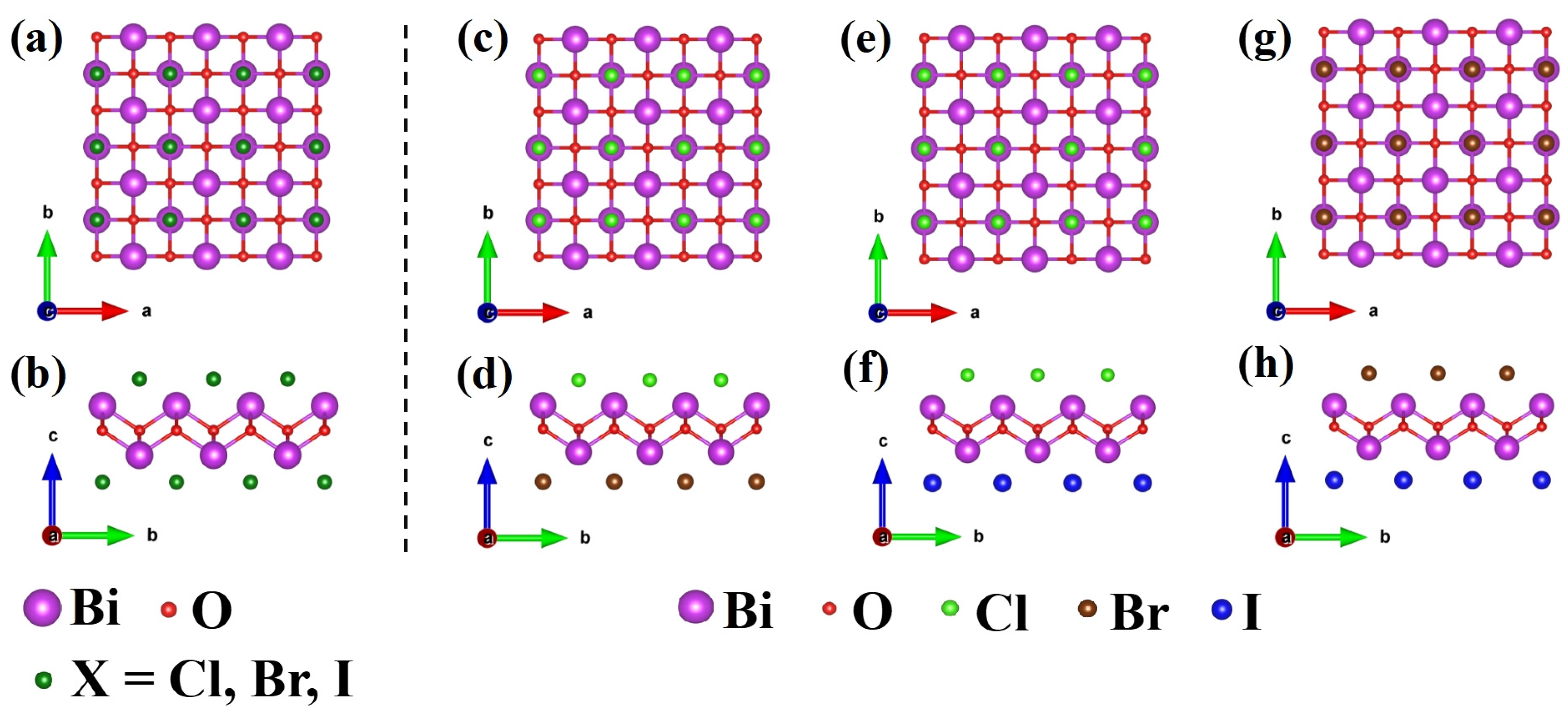
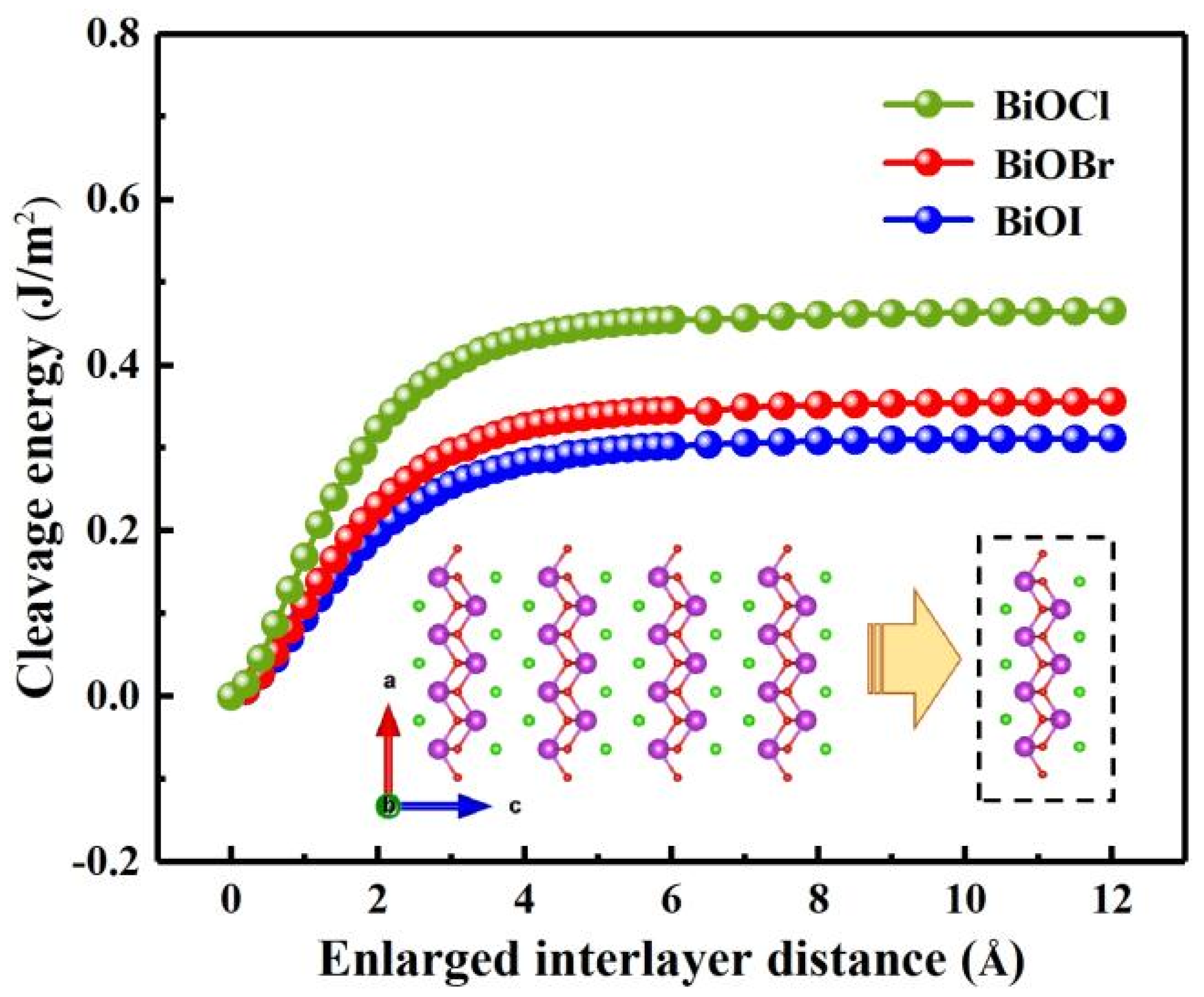
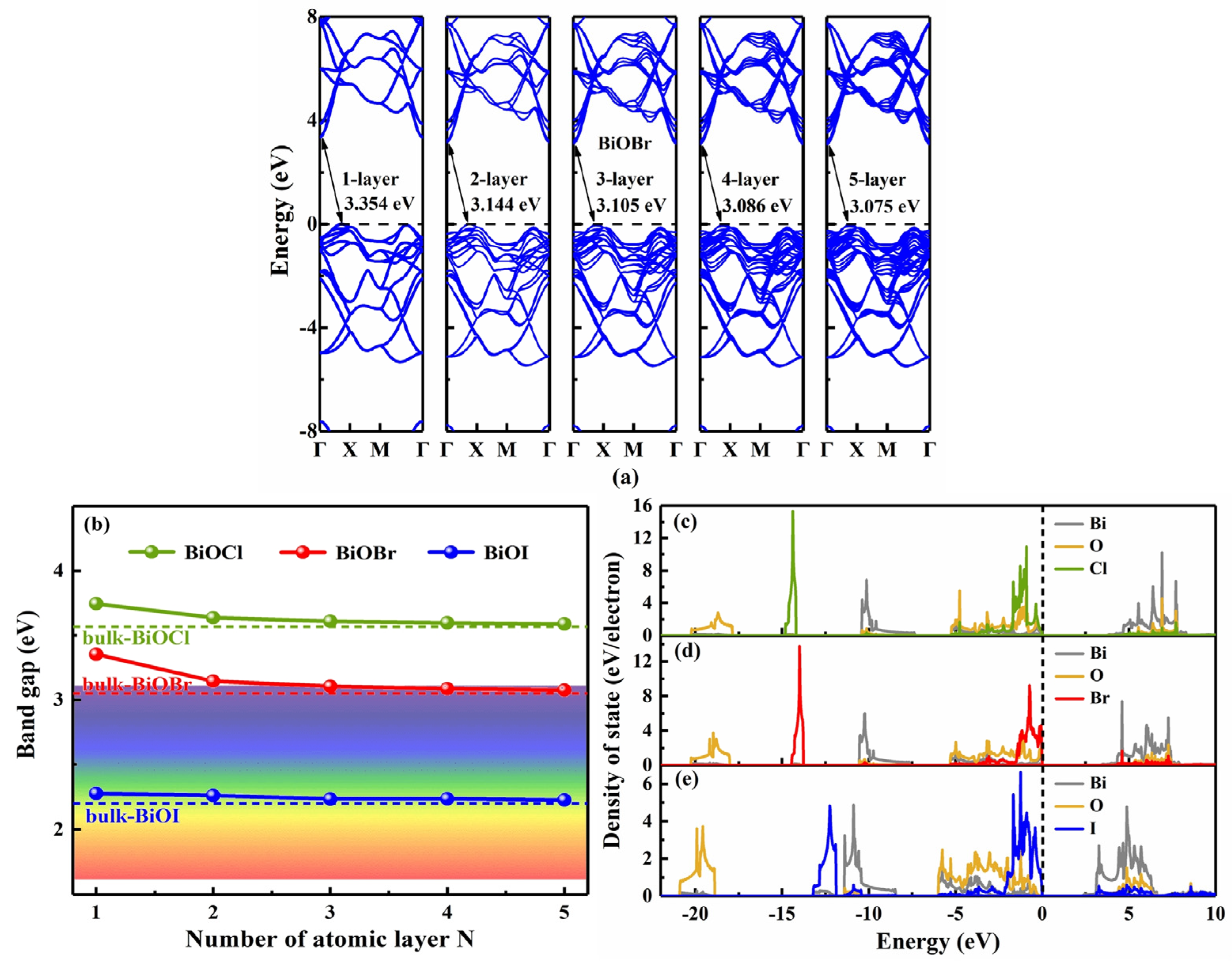
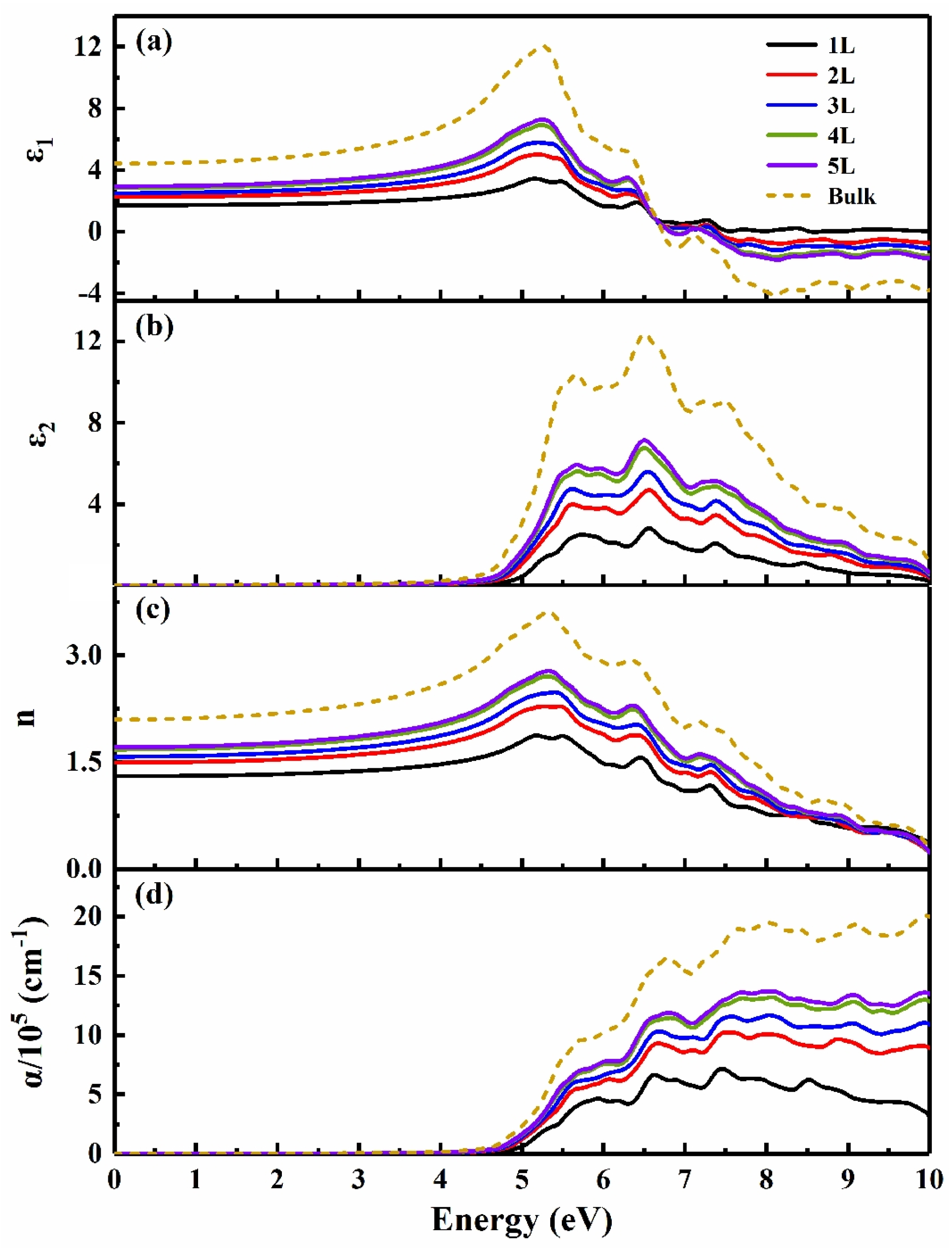
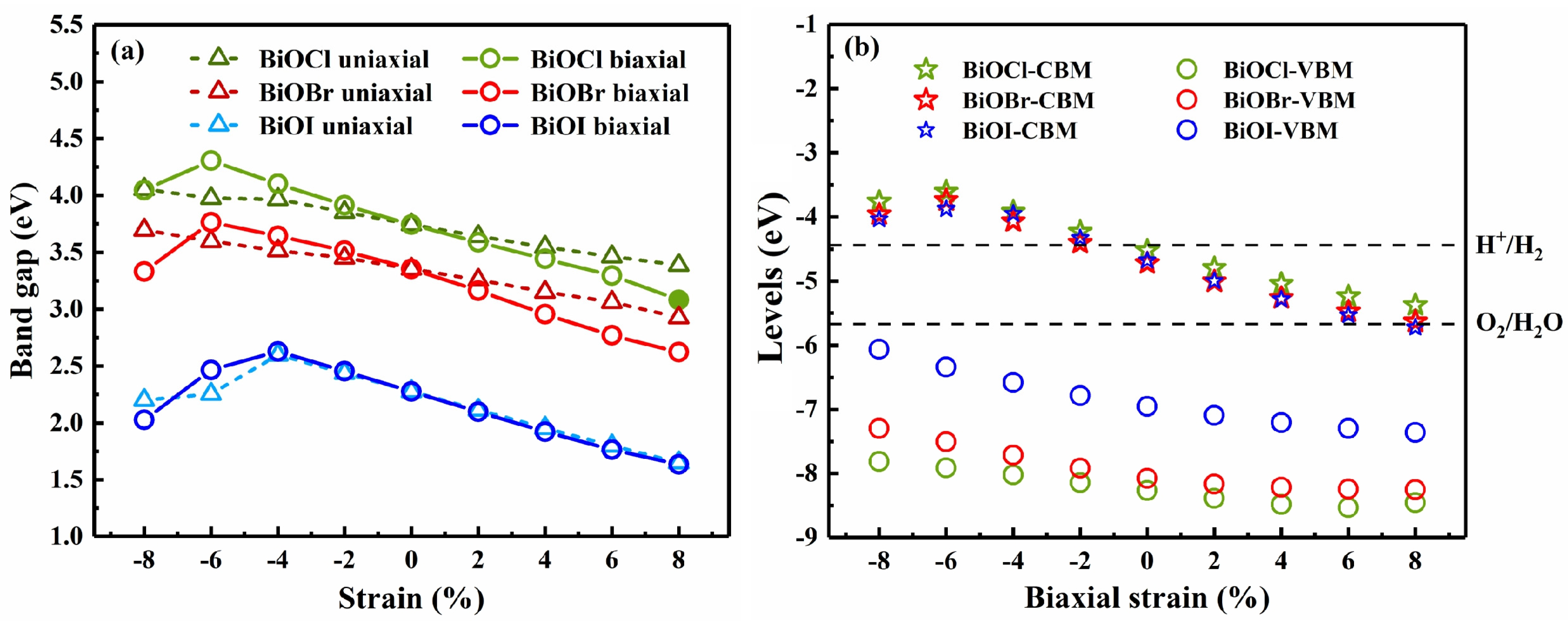
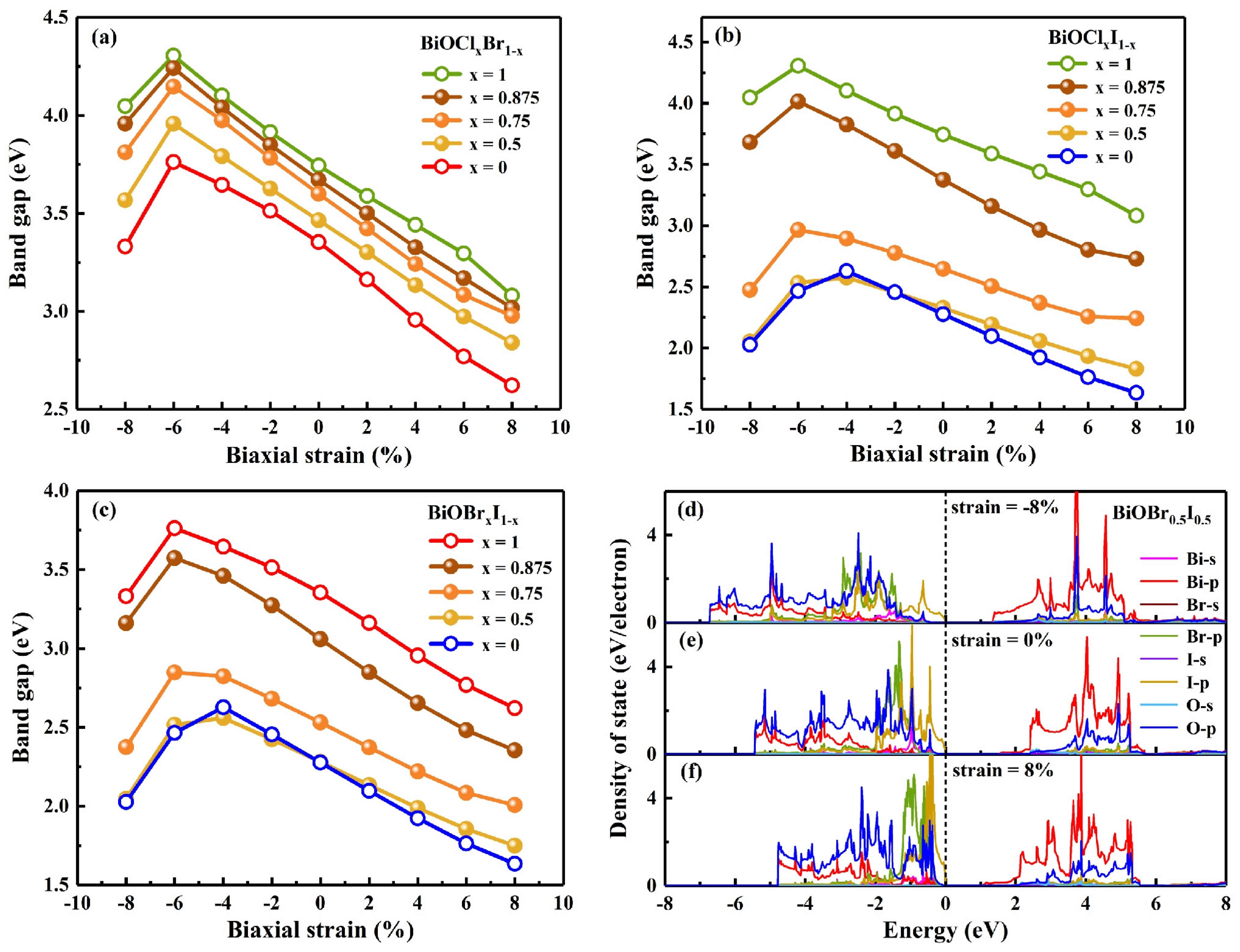
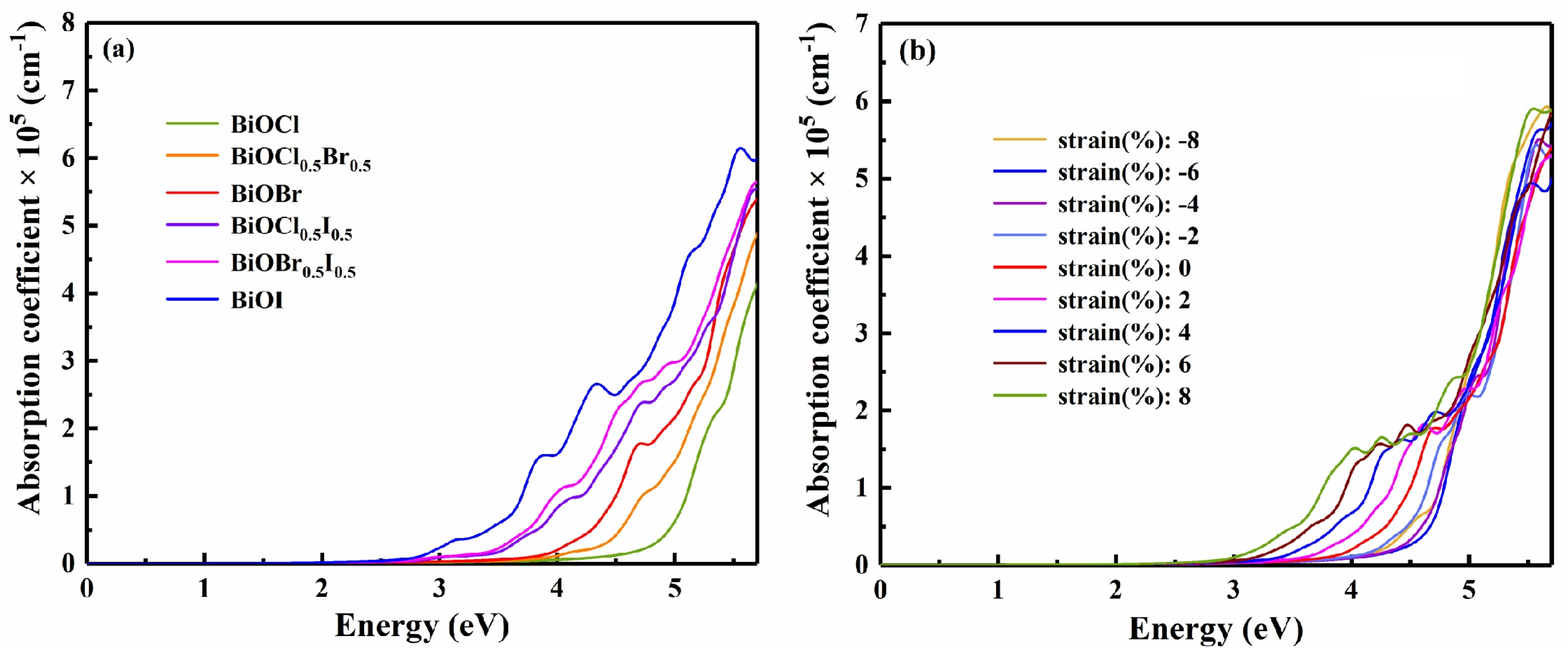
| System | BiOCl | BiOBr | BiOI |
|---|---|---|---|
| a (Å) | |||
| 1 Layer | 3.876 | 3.926 | 4.015 |
| 2 Layers | 3.891 | 3.934 | 4.016 |
| 3 Layers | 3.896 | 3.937 | 4.017 |
| 4 Layers | 3.899 | 3.939 | 4.018 |
| 5 Layers | 3.900 | 3.940 | 4.018 |
| Bulk | 3.907 | 3.943 | 4.020 |
Disclaimer/Publisher’s Note: The statements, opinions and data contained in all publications are solely those of the individual author(s) and contributor(s) and not of MDPI and/or the editor(s). MDPI and/or the editor(s) disclaim responsibility for any injury to people or property resulting from any ideas, methods, instructions or products referred to in the content. |
© 2023 by the authors. Licensee MDPI, Basel, Switzerland. This article is an open access article distributed under the terms and conditions of the Creative Commons Attribution (CC BY) license (https://creativecommons.org/licenses/by/4.0/).
Share and Cite
Zhou, Y.; Cheng, B.; Huang, S.; Huang, X.; Jiang, R.; Wang, X.; Zhang, W.; Jia, B.; Lu, P.; Song, H.-Z. The Tunable Electronic and Optical Properties of Two-Dimensional Bismuth Oxyhalides. Nanomaterials 2023, 13, 2798. https://doi.org/10.3390/nano13202798
Zhou Y, Cheng B, Huang S, Huang X, Jiang R, Wang X, Zhang W, Jia B, Lu P, Song H-Z. The Tunable Electronic and Optical Properties of Two-Dimensional Bismuth Oxyhalides. Nanomaterials. 2023; 13(20):2798. https://doi.org/10.3390/nano13202798
Chicago/Turabian StyleZhou, Yong, Beitong Cheng, Shuai Huang, Xingyong Huang, Ruomei Jiang, Xule Wang, Wei Zhang, Baonan Jia, Pengfei Lu, and Hai-Zhi Song. 2023. "The Tunable Electronic and Optical Properties of Two-Dimensional Bismuth Oxyhalides" Nanomaterials 13, no. 20: 2798. https://doi.org/10.3390/nano13202798
APA StyleZhou, Y., Cheng, B., Huang, S., Huang, X., Jiang, R., Wang, X., Zhang, W., Jia, B., Lu, P., & Song, H.-Z. (2023). The Tunable Electronic and Optical Properties of Two-Dimensional Bismuth Oxyhalides. Nanomaterials, 13(20), 2798. https://doi.org/10.3390/nano13202798







